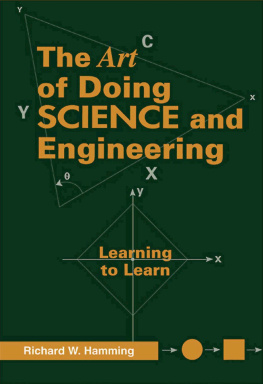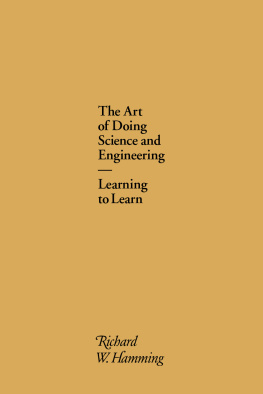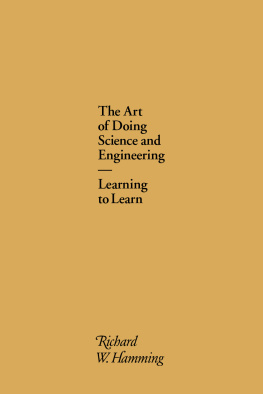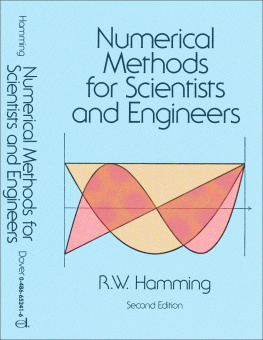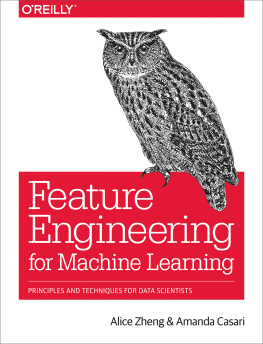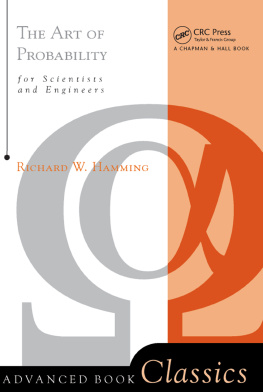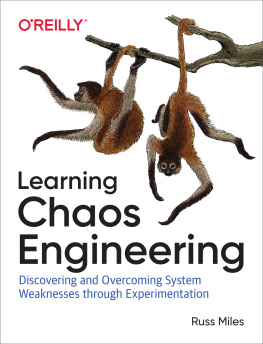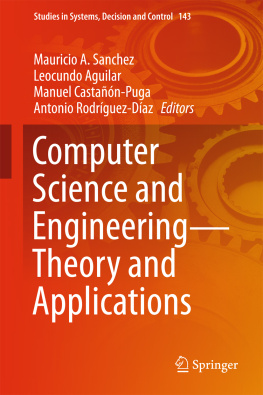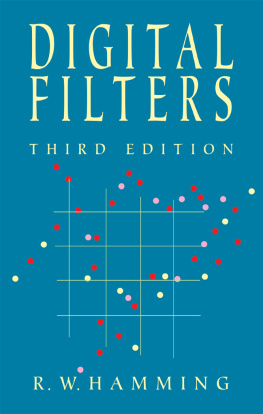Richard R. Hamming - The Art of Doing Science and Engineering: Learning to Learn
Here you can read online Richard R. Hamming - The Art of Doing Science and Engineering: Learning to Learn full text of the book (entire story) in english for free. Download pdf and epub, get meaning, cover and reviews about this ebook. year: 2003, publisher: CRC Press, genre: Religion. Description of the work, (preface) as well as reviews are available. Best literature library LitArk.com created for fans of good reading and offers a wide selection of genres:
Romance novel
Science fiction
Adventure
Detective
Science
History
Home and family
Prose
Art
Politics
Computer
Non-fiction
Religion
Business
Children
Humor
Choose a favorite category and find really read worthwhile books. Enjoy immersion in the world of imagination, feel the emotions of the characters or learn something new for yourself, make an fascinating discovery.
- Book:The Art of Doing Science and Engineering: Learning to Learn
- Author:
- Publisher:CRC Press
- Genre:
- Year:2003
- Rating:5 / 5
- Favourites:Add to favourites
- Your mark:
- 100
- 1
- 2
- 3
- 4
- 5
The Art of Doing Science and Engineering: Learning to Learn: summary, description and annotation
We offer to read an annotation, description, summary or preface (depends on what the author of the book "The Art of Doing Science and Engineering: Learning to Learn" wrote himself). If you haven't found the necessary information about the book — write in the comments, we will try to find it.
The Art of Doing Science and Engineering: Learning to Learn — read online for free the complete book (whole text) full work
Below is the text of the book, divided by pages. System saving the place of the last page read, allows you to conveniently read the book "The Art of Doing Science and Engineering: Learning to Learn" online for free, without having to search again every time where you left off. Put a bookmark, and you can go to the page where you finished reading at any time.
Font size:
Interval:
Bookmark:

The Art of Doing Science and Engineering
The Art of Doing Science and Engineering
Learning to Learn
Richard W.Hamming
U.S. Naval Postgraduate School
Monterey, California
GORDON AND BREACH SCIENCE PUBLISHERS
Australia Canada China France Germany India
Japan Luxembourg Malaysia The Netherlands
Russia Singapore Switzerland Thailand
United Kingdom
This edition published in the Taylor & Francis e-Library, 2004.
Copyright 1997 OPA (Overseas Publishers Association)
Amsterdam B.V.Published in The Netherlands under license
by Gordon and Breach Science Publishers.
All rights reserved.
No part of this book may be reproduced or utilized in any
form or by any means, electronic or mechanical, including
photocopying and recording, or by any information storage
or retrieval system, without permission in writing from the
publisher. Printed in India.
Amsteldijk 166
1st Floor
1079 LH Amsterdam
The Netherlands
British Library Cataloguing in Publication Data
Hamming, R.W. (Richard Wesley), 1915
The art of doing science and engineering: learning to
learn
1. Science 2. Engineering
I. Title
500
ISBN 0-203-45071-X Master e-book ISBN
ISBN 0-203-45642-4 (MP PDA Format)
ISBN 90-5699-501-4 (Print Edition)
Copyright 2003/2004 Mobipocket.com. All rights reserved.
Reader's Guide
This ebook has been optimized for MobiPocket PDA.
Tables may have been presented to accommodate this Device's Limitations.
Table content may have been removed due to this Device's Limitations.
Image presentation is limited by this Device's Screen resolution.
All possible language characters have been included within the Font handling ability of this Device.
After many years of pressure and encouragement from friends, I decided to write up the graduate course in engineering I teach at the U.S.Naval Postgraduate School in Monterey, California. At first I concentrated on all the details I thought should be tightened up, rather than leave the material as a series of somewhat disconnected lectures. In class the lectures often followed the interests of the students, and many of the later lectures were suggested topics in which they expressed an interest Also, the lectures changed from year to year as various areas developed. Since engineering depends so heavily these days on the corresponding sciences, I often use the terms interchangeably.
After more thought I decided that since I was trying to teach "style" of thinking in science and engineering, and "style" is an art, I should therefore copy the methods of teaching used for the other artsonce the fundamentals have been learned. How to be a great painter cannot be taught in words; one learns by trying many different approaches that seem to surround the subject. Art teachers usually let the advanced student paint, and then make suggestions on how they would have done it, or what might also be tried, more or less as the points arise in the student's headwhich is where the learning is supposed to occur! In this series of lectures I try to communicate to students what cannot be said in wordsthe essence of style in science and engineering. I have adopted a loose organization with some repetition since this often occurs in the lectures. There are, therefore, digressions and storieswith some told in two different placesall in the somewhat rambling, informal style typical of lectures.
I have used the "story" approach, often emphasizing the initial part of the discovery, because I firmly believe in Pasteur's remark, "Luck favors the prepared mind." In this way I can illustrate how the individual's preparation before encountering the problem can often lead to recognition, formulation, and solution. Great results in science and engineering are "bunched" in the same person too often for success to be a matter of random luck.
Teachers should prepare the student for the student's future, not for the teacher's past. Most teachers rarely discuss the important topic of the future of their field, and when this is pointed out they usually reply: "No one can know the future." It seems to me the difficulty of knowing the future does not absolve the teacher from seriously trying to help the student to be ready for it when it comes. It is obvious the experience of an individual is not necessarily that of a class of individuals; therefore, any one person's projection into the future is apt to be somewhat personal and will not be universally accepted. This does not justify reverting to impersonal surveys and losing the impact of the personal story.
Since my classes are almost all carefully selected navy, marine, army, air force, and coast guard students with very few civilians, and, interestingly enough, about 15% very highly selected foreign military, the students face a highly technical futurehence the importance of preparing them for their future and not just our past.
The year 2020 seems a convenient date to center the preparation for their futurea sort of 20/20 foresight, as it were. As graduate students working toward a master's degree, they have the basics well in hand. That leaves me the task of adding "style" to their education, which in practice is usually the difference between an average person and a great one. The school has allowed me great latitude in trying to teach a completely non-technical course; this course "complements" the more technical ones. As a result, my opening words, occasionally repeated, are: "There is really no technical content in the course, though I will, of course, refer to a great deal of it, and hopefully it will generally be a good review of the fundamentals of what you have learned. Do not think it is the content of the courseit is only illustrative material. Style of thinking is the center of the course."
The subtitle of this book, Learning to Learn, is the main solution I offer to help students cope with the rapid changes they will have to endure in their fields. The course centers around how to look at and think about knowledge, and it supplies some historical perspectives that might be useful.
This course is mainly personal experiences I have had and digested, at least to some extent. Naturally one tends to remember one's successes and forget lesser events, but I recount a number of my spectacular failures as clear examples of what to avoid. I have found that the personal story is far, far more effective than the impersonal one; hence there is necessarily an aura of "bragging" in the book that is unavoidable.
Let me repeat what I earlier indicated. Apparently an "art"which almost by definition cannot be put into wordsis probably best communicated by approaching it from many sides and doing so repeatedly, hoping thereby students will finally master enough of the art, or if you wish, style, to significantly increase their future contributions to society. A totally different description of the course is: it covers all kinds of things that could not find their proper place in the standard curriculum.
The casual reader should not be put off by the mathematics; it is only "window dressing" used to illustrate and connect up with earlier learned material. Usually the underlying ideas can be grasped from the words alone.
It is customary to thank various people and institutions for help in producing a book. Thanks obviously go to AT&T Bell Laboratories, Murray Hill, New Jersey, and to the U.S.Naval Postgraduate School, especially the Department of Electrical and Computer Engineering, for making this book possible.
Next pageFont size:
Interval:
Bookmark:
Similar books «The Art of Doing Science and Engineering: Learning to Learn»
Look at similar books to The Art of Doing Science and Engineering: Learning to Learn. We have selected literature similar in name and meaning in the hope of providing readers with more options to find new, interesting, not yet read works.
Discussion, reviews of the book The Art of Doing Science and Engineering: Learning to Learn and just readers' own opinions. Leave your comments, write what you think about the work, its meaning or the main characters. Specify what exactly you liked and what you didn't like, and why you think so.

